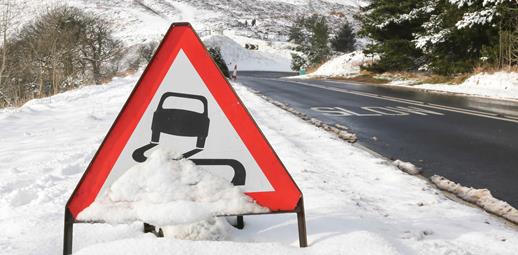
Driving in icy conditions can be dangerous, and many people choose to stay at home until the weather thaws. But if you do need to drive on icy roads, here are some steps you can take to stay safe.
Easy as Hack
If your car thermometer is close to zero degrees Celsius, there’s a good chance the roads are icy, and you may encounter black ice on the road.
At a glance
- Check the weather forecast and transport news before you travel
- Learn how to handle your vehicle on icy roads safely
- To avoid ice driving altogether, reschedule your journey for hours when the sun is shining
how to prepare for driving on ice
Prepare yourself and your car before driving on ice. You should always maintain your vehicle in good condition, especially important during winter. Follow the Highway Code’s advice: [1]
- Avoid driving unless it’s necessary. The Highway Code strongly advises against driving on ice or snow unless your journey is essential.
- Check traffic reports. See if your local weather forecast has issued ice or snow warnings before you set off. Ensure the route has no delays, and more icy or snowy weather is unlikely.
- Plan your journey. If you must drive, allow more time for your trip and pack an emergency kit in the boot. We’ve listed the items to take below.
- Wear warm clothes and appropriate footwear. Take warm clothing and sturdy footwear, such as waterproof boots or shoes with soles that provide grip. You should also pack a warm drink and food in case your vehicle breaks down.
- De-ice and de-mist your windscreen. All your windows, mirrors, and number plate must be free of snow and ice so that you can see clearly. Learn how to defrost your car windows and windshield.
- Top up with the correct freeze-resistant windscreen washer fluid. The law requires drivers to have windscreen wipers, and most vehicles must have windscreen washer fluid.[2]
- Make sure your lights are working. Turn on your headlights, fog lights, side and indicator lights and walk around the car, checking them in sequence. Make sure they are defrosted too.
- Check your wipers. Before driving on ice or in snow, ensure your wipers have no holes or tears that could affect their performance. Don’t turn them on or pull them if they are frozen to the windscreen, as you could damage them.
- Check your fuel or EV charge. Ensure you have more than enough petrol for your journey, or that you have charged your electric vehicle. Read our guide to electric car charging. Check your oil level when the car is cold.
- Check that your tyres are in good condition. Consider buying winter tyres if you drive regularly in ice and snow, as they maximise traction.[3]
WHAT SHOULD I CARRY IN THE CAR WHEN DRIVING IN SNOW AND ICE?
No one likes breaking down when driving in snow and ice. However, carrying an emergency kit in the car means you’re prepared should bad luck strike. Items you may want to include:
- De-icer spray and an ice scraper
- Torch – wind-up or battery
- Blanket and warm clothes – for comfort, if you get stuck
- Jump leads – in case of a breakdown
- Breakdown emergency contact
- Fully charged phone – to let people know where you are
- Portable phone charger – in case your mobile battery dies
- First aid kit – to help yourself or anyone else who is injured
- Something to eat and drink – until help arrives
- Cat litter or sand – to create traction under tyres
- Shovel – to remove snow
HOW TO DRIVE ON ICY ROADS
- Drive cautiously and smoothly when roads are icy, as you can skid at high speeds. Roads can remain slippery even if local authorities or National Highways have salted them.
- Pull away in second or third gear using low revs, as this helps to avoid wheel spin.[4] An automatic car should have a winter mode, or you can switch to manual.
- Why should you drive in a high gear on ice? Driving in the highest gear without stalling helps the car to maintain traction on the ice.
- Accelerate, brake, steer and change gear as smoothly as possible to avoid potential skidding. You can test your tyres’ grip by braking gently in a safe place.
- Extend the distance between you and the vehicle in front, as the stopping distance can be 10 times greater on ice than on a dry road.1
- Use dipped headlights in heavy snow, as the snow will impair your visibility. Dipped headlines ensure you do not dazzle other drivers.
- Watch out for hail. Hail can quickly cover the road with a layer of thin ice. Drive much slower, so you can handle the car with ease.
- Try not to stop while driving uphill unless necessary, and avoid starting from a complete stop on a slope because your tires might struggle to grip the road.
how to brake on icy roads
The chances are high that you will have to brake on icy roads at some point during your journey. It’s essential to keep calm. Here’s what to do if you have to brake:
- Tap the brake pedal lightly on and off, steering straight in low gear. If you do not brake sharply or erratically, you’ll avoid the risk of skidding.
- At a low speed, finish braking before a turn and don’t touch the pedal while turning, especially when driving downhill.
- Instead of braking using the pedal, use your gears to slow down.
- If it’s too late to stop or difficult to stop, reduce your speed to increase your ability to steer away from danger. [5]
WHAT DISTANCE SHOULD YOU LEAVE BETWEEN CARS ON AN ICY ROAD?
An icy road requires you to leave at least 10 times more space between you and the car in front, because stopping distances are 10 times higher than on a dry road.[1]
HOW do you know if you are driving on ice?
If you’re wondering what would suggest you’re driving on ice, here’s what to keep in mind.
Ice is challenging to spot, as it often resembles water or a dry road. However, you might notice its glossy appearance. The sheen from it may glint in sunlight or when your headlights hit it.
You are more likely to see ice on quiet roads and shady areas, such as under bridges, tunnels and underpasses [5]. One way to tell is if the tyres are less noisy than they are on a dry road. [5]
Another suggestion that you’re driving on ice is the behaviour of cars in front of you. You’ll know you’re about to drive on ice if you see them sliding about or notice vehicles that have veered off the road.
HOW TO IDENTIFY BLACK ICE
Black ice can be particularly tricky to spot because it’s transparent. You can see the colour of the road underneath, which makes it look black. You’ll see less black ice on busy roads compared to quiet ones.
Keep an eye out for glossy, wet-looking tarmac in shady spots and vehicles that fail to grip the road in front of you. If they’re sliding about, there’s a good chance they’ve hit black ice.
Another way to prepare yourself for black ice is to use your car thermometer as a guide. If the temperature is at or below freezing, be extra cautious about the possibility of black ice.
what should you do if you skid on icy roads?
If your car started to skid on an icy road, it’s vital to stay calm. Drive cautiously at a low speed to make it easier to correct the skid and stay safe.
Other tips to help you stay in control on icy roads include:
- Try to anticipate the need to stop or slow down
- Brake gently and don’t slam your foot down
- Perform manoeuvres extra slowly
- Use the highest gear possible to avoid wheel spin
- If your vehicle starts to skid, don’t brake hard, as you could make the skid worse
- Ease off the accelerator and steer slightly in the skid’s direction until you regain control
- Look where you want the car to go
- Stick to a lower gear to control the car if you’re going downhill
- Don’t oversteer or over-correct your steering
- Don’t take your hands off the steering wheel
what should you do if your car gets stuck in snow or ice?
Here’s what you should do if your car gets stuck in snow or ice:
- Don’t keep trying to move if your wheels are just spinning
- Use a shovel to clear snow from under your tyres – adding sand or cat litter beneath the tyres can add traction
- Shift from forward to reverse and back
- Ease off the accelerator and use a light touch
- If you can’t restart your car, check that snow has not blocked your exhaust pipe
- You can stay warm by running your engine and sitting in your vehicle (only run the engine for 10-15 minutes each hour)
Should you help other drivers stuck on icy roads?
In general, it's safest not to stop and assist drivers stuck on icy roads, as doing so can increase the risk of accidents. However, if you witness someone in distress, it's important to call for help, such as contacting emergency services, rather than attempting to intervene directly.
ARE YOU COVERED BY CAR INSURANCE TO DRIVE IN ICY CONDITIONS?
Typically, you will be covered to drive in icy conditions during an amber or red weather warning for ice and snow if you have a comprehensive car insurance policy. You should also tax your car and ensure it has a valid MOT.
However, the type of damage and situations insurers will cover can vary, so it’s best to check the policy wording. Read our policy documents.
Also, an insurer might refuse your claim if you drove irresponsibly or ignored warnings like road closures, especially during extreme weather events.
Protect yourself when driving in icy conditions
The chance of accidents increases when you’re driving in icy conditions. Driving safely on icy roads means taking precautions.
Ensure you have suitable protection with a car insurance policy that includes reimbursement for transport costs if you get stuck in snow or arrangements to get you to your UK destination. Read our car insurance policy booklet.
Get a quote for Ageas car insurance.
FAQs
Do you need winter tyres?
You should consider winter tyres if you drive regularly in icy or snowy conditions, as they provide improved traction.[3]
do you need to inform your car insurer about fitting winter tyres?
You don’t need to inform your insurer about fitting winter tyres, provided they are a standard size and specification for your car.
what gear should you drive on ice in?
- Pull away in second gear (or third if you can)
- Stay in a higher-than-normal gear to move gently on a slippery surface
- Drive slowly to avoid wheel-spin [5]
how fast should you drive on ice?
You shouldn’t drive fast on ice. Aim for a slow speed that gives you enough time to react to unexpected icy conditions on the road.[4]
How fast you go depends on several factors, including:
- Number of other cars on the road
- Type of road you are driving on
- Whether there are upward and downward slopes
is it illegal to drive with snow on your car?
All windows on your car must be clear by law. It’s best to sweep away any loose snow from the bonnet and roof as well, because it would be an offence if snow shifted and obstructed your view of the road.
how do you drive uphill in snow?
It can be tricky driving uphill in snow. Here’s how to do it:
- Don’t attempt to drive up the hill until it’s free of traffic
- Keep a constant speed
- Avoid changing gear
how do you drive downhill in snow?
Driving downhill in snow can be as challenging as driving uphill.
- Don’t attempt to drive down the hill until it’s free of traffic
- Drive in a low gear
- Use the brakes gently only when needed
- Use engine braking – a technique to gradually slow the car by taking your foot off the accelerator and gently putting it into a lower gear
how do you drive on ice in an automatic car?
If you have to drive on ice in an automatic vehicle, consider the following:
- Some automatic cars have a ‘winter mode’ or ‘snow mode
- Drive smoothly and slowly
- Avoid harsh acceleration or braking
how do you drive on ice in an electric vehicle?
When driving on ice in an EV, remember:
- EVs are heavy, so it’s crucial to drive slowly to avoid sliding or loss of control
- Reduce regenerative braking
does car insurance cover accidents on icy roads?
Generally, car insurance covers accidents that occur while driving on icy roads, provided the driver is not deemed to be negligent or driving in an illegal manner.
Sources
[1] https://www.highwaycodeuk.co.uk/icy-and-snowy-weather.html
[3] https://www.rac.co.uk/drive/advice/winter-driving/should-i-buy-winter-tyres/
[4] https://www.kwik-fit.com/blog/driving-in-icy-conditions
[5] https://aphc.co.uk/news/guest-blog-the-aa-how-to-drive-in-snow/


